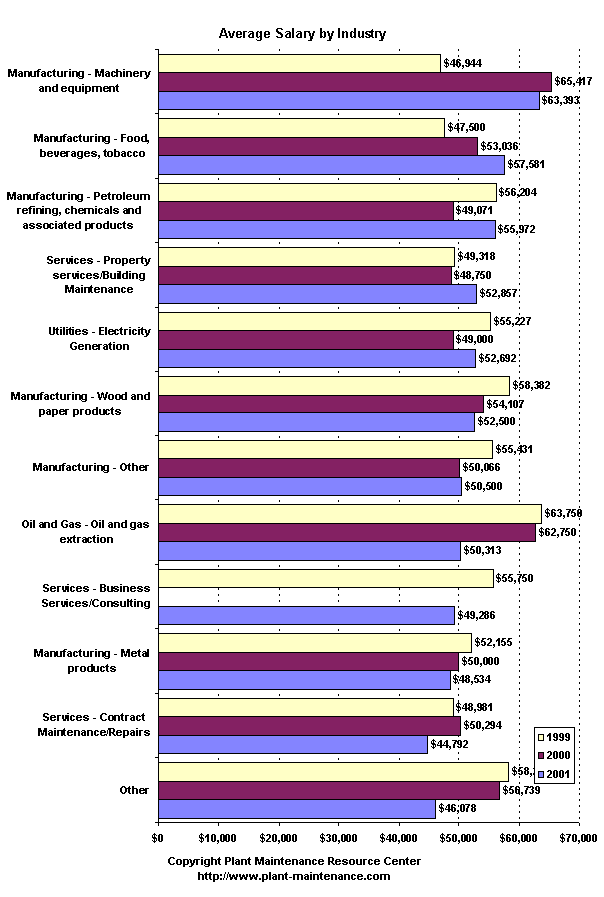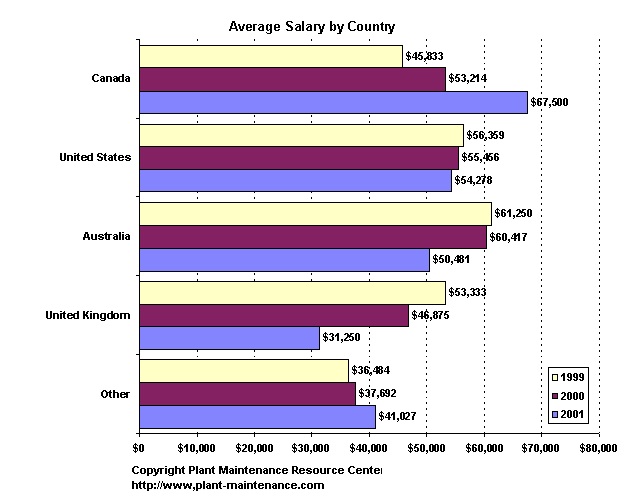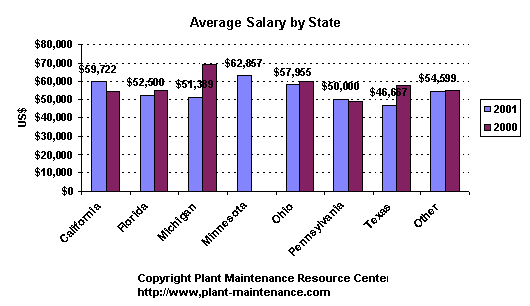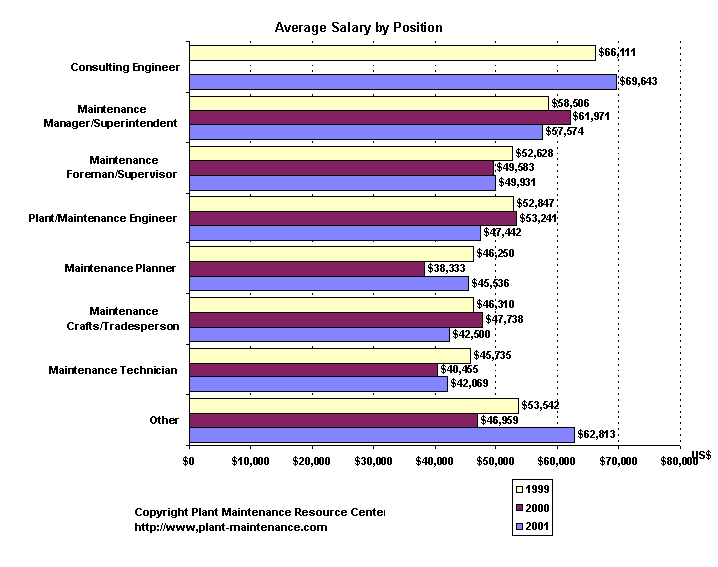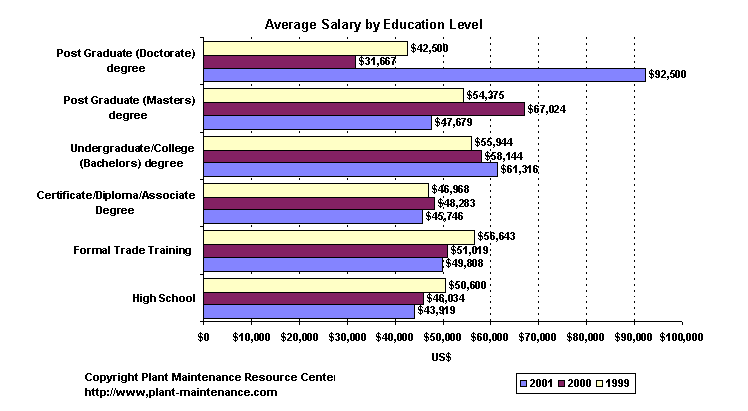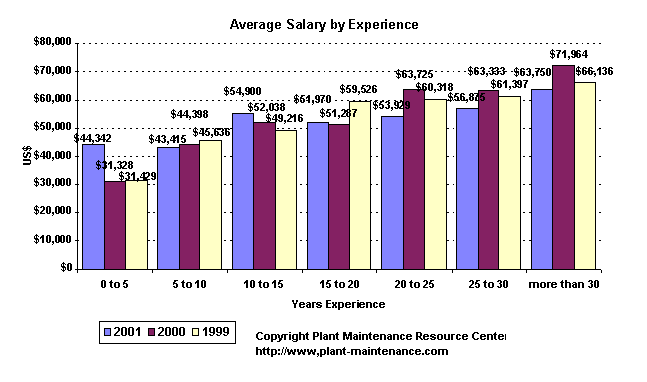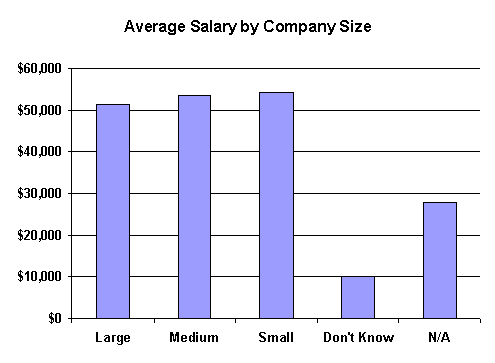|
| Plant Maintenance Resource Center
2001 Maintenance Salary Survey Results
| |
|
|
|
|
|
2001 Maintenance Salary Survey ResultsOverviewThe third annual survey of salaries in the Maintenance sector was conducted on the Plant Maintenance Resource Center website between January and April 2001. This salary survey is a regular, annual event. The 1999 Salary survey results are available here, and the 2000 Salary Survey results are available here. If you would like to be notified via e-mail when the 2002 Maintenance Salary survey opens, please send an e-mail to salary-survey2002@plant-maintenance.com. Raw Data - OverviewVoluntary (and confidential) responses were sought to the survey, and 248 valid responses were received. This was approximately 22% fewer than the 320 responses received in 2000, and 15% fewer than were received in the 1999 survey. Raw Data - IndustriesThe greatest number of responses were from individuals in the Manufacturing industries. There were comparably fewer responses from the Maintenance Contracting industry and from Maintenance Consultants in this years survey, compared with last year. A complete list of industries represented is tabulated below.
Raw Data - CountriesOver 55% of the responses received were from the USA, followed by Australia, Canada and the United Kingdom as the countries with the next greatest number of responses. In comparison with previous years, there is a much higher proportion of responses from Australians, and a broader range of countries represented.
Raw Data - Job PositionsAs in previous years, the positions with the greatest representation in the survey were Maintenance Managers/Superintendents, followed by Plant/Maintenance Engineers, Maintenance Foremen/Supervisors, Maintenance Technicians, Maintenance Planners and Maintenance Trades/Craftspeople.
Raw Data - Educational LevelsThe distribution of educational levels was similar to last year, although there was a significant increase in the proportion of respondents holding Master's qualifications.
Raw Data - Work ExperienceA wide range of work experience was represented.
Raw Data - SalariesThe total annual earnings, inclusive of all benefits, displayed a similar distribution to last year, with overall salaries slightly lower than previous years.
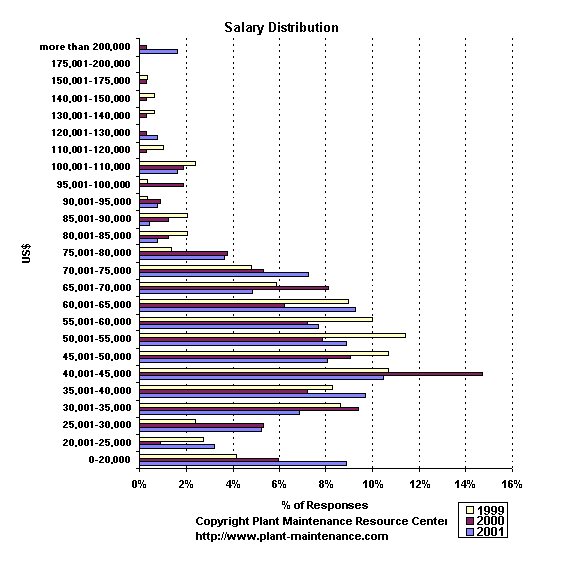 Overall ResultsThe median salary band was US$45,001-$50,000, as was the case in 2000. In 1999, the median salary band was US$50,001-$55,000. Assuming the average salary for each band is the midpoint of each band, the mean salary in 2001 is US$51,290. This is approximately $1,300 or 2.3% lower than the mean 2000 salary of US$52,523. It is also around $2,200 or 4.2% lower than the mean salary of US$53,521 in 1999. However, the changing mix of respondents, and the strength of the US$ in comparison to other currencies partially explains this variation, rather than any underlying trend in salary movements. By way of comparison, the following table indicates the exchange rate movements between the US$ and three other key currencies between 1 January 2000, and 1 January 2001.
Salary by IndustryAn analysis of salaries by industry (for those industries with 5 or more responses) indicated that the once again, the industry paying the highest salaries was Manufacturing:Machinery and Equipment. There was a large drop in the salaries being paid in Oil & Gas extraction, and "Other". There were only 8 respondents in 2001 from the Oil & Gas extraction sector (compared with 10 the preceding year), and the key difference is that there were two highly paid responses (>$100,000) received in 2000, but none in this band in 2001. As a result of the low number of responses, this has had a significant influence on the result. Note that, for the purpose of this analysis, only industries containing 5 or more respondents were included. The overall result is shown graphically below.
Salaries by CountryOnce again, only countries with 5 or more respondents were included in this analysis, which showed that the highest salaries were to be obtained in Canada, followed by the US and Australia. The apparent drop in salaries in Australia can be almost totally explained by exchange rate movements in the last 12 months. At the beginning of 2000, the $A was valued at approximately US$0.65. At the beginning of 2001, this had dropped to US$0.55. This adverse movement in exchange rates has also affected the results for the United Kingdom to a minor extent. Note the apparent continuing increase in Canadian salaries. As usual, it should be noted that tax rates will differ between countries, as will the cost of living, so direct comparisons of salaries between countries should be treated cautiously. As already noted, changes in exchange rates mean that comparisons, year on year, for non-US countries should also be treated cautiously.
Salaries by StateAverage salaries are given for those states with more than 5 responses in the following chart. However, given the low number of results for each state, meaningful comparison between states is almost impossible.
Salaries by PositionYet again, only positions with more than 5 respondents were included in this analysis. The highest paid position (although there were a small number of respondents) was Consulting Engineer. Maintenance Managers/Superintendents were the next highest paid positions, followed by Maintenance Supervisors/Foremen who were paid more than Plant/Maintenance Engineers, the opposite of last year's result. Maintenance Planners continue to be paid less than Maintenance Foremen/Supervisors, although last year's extremely low salary for Maintenance Planners appears to have been an aberration.
Salary by EducationBased on this year's results, it would appear that increasing levels of formal educational qualifications generally lead to increasing salaries. The result for Doctorate salaries is probably distorted by there having only been one respondent with this qualification. Having completed a Bachelors/College degree appears to result in an average salary more than 20% higher than those having completed formal trade/craft qualifications.
Salary by ExperienceOnce again, this survey highlights that experience is an important factor in generating additional salary, although this year it would appear that starting salaries are higher than shown in previous years' surveys.
Salary by Company SizeContrary to what you may believe, it appears that salaries at larger organisations are slightly lower than at smaller ones, although the differences are marginal.
Future enhancementsIn the survey, opportunity was given to respondents to comment on the survey, and many valuable suggestions were made. As the survey was, for obvious reasons, confidential, we were unable to respond directly to those making the comments, but take this opportunity to thank those that took the time offer their comments and suggestions. ConclusionIn summary, the main conclusions from this survey are:
Throughout the year, the Plant Maintenance Resource Center runs a series of surveys on topics of interest to Maintenance professionals. To access the latest survey, visit here © Plant Maintenance Resource Center 2000
If you wish to copy or distribute this article, please email me to ask for permission first!
Copyright 1996-2009, The Plant Maintenance Resource Center . All Rights Reserved.
| ||||||||||||||||||||||||||||||||||||||||||||||||||||||||||||||||||||||||||||||||||||||||||||||||||||||||||||||||||||||||||||||||||||||||||||||||||||||||||||||||||||||||||||||||||||||||||||||||||||||||||||||||||||||||||||||||||||||||||||||||||||||||||||||||||||||||||||||||||||||||||||||||||||||||||||||||||||||||||||||||||||||||||||||||||||||||||||||||||||||||||||||||||||||||||||||||||||||||||||||||||||||||||||||||||||||||||||||||||||||||||||||||||||||||||||||||||||||||||||||||||||||||||||||||||||||||||||||||||||||||||||||||||||||||||||||||||||||||||||||||||||||||||||||||||||||||||||||||||||||||||||||||||||||||||||||||||||||||||||||||||||||||||||||||||||||||||||||||||||||||||||||||||||||||||||||||||||||||||||||||||||||||||||||||||||||||||||||||||||||||||||||||||||||||||||||||||||||||||||||||||||||||||||||||||||||||||||||||||||||||||||||||||||||||||||||||||||||||||||||||||||||||||||||||||||||||||||||||||||||||||||||||||||||||||||||||||||||||||||||||||||||||||||||||||||||||||||||||||||||

